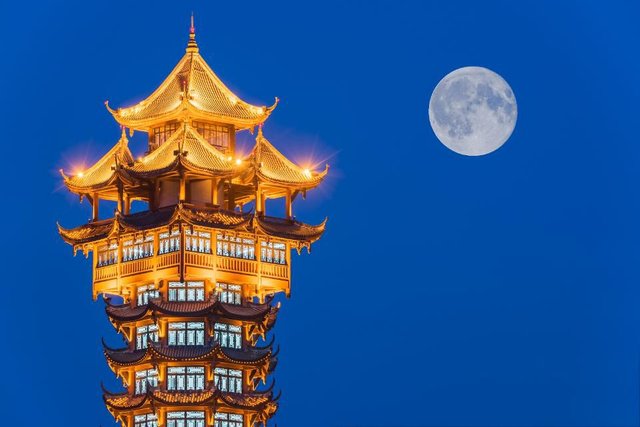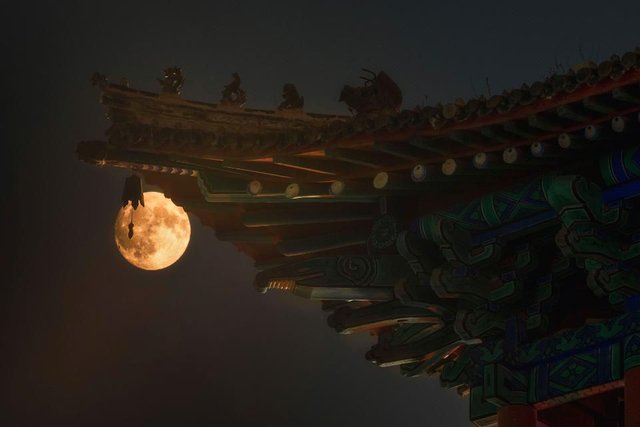A city in China is planning to launch a satellite planned to be eight times as bright as the Full Moon to illuminate urban streets at night, but one astronomer thinks that it could worsen light pollution by a factor of 47.
As reported by the People's Daily Online, scientists in the city of Chengdu in southwest China think they may be able to cut streetlights by launching an "illumination satellite" that could provide enough light for between six and 50 square miles of the city.

Jiutian traditional tower illuminated at night with full moon in the background, Chengdu, China
The plans for 202o were outlined by Wu Chunfeng, chairman of Chengdu Aerospace Science and Technology Microelectronics System Research Institute Co (CASX) who said that the satellite would complement moonlight. However, China Daily reported that three man-made moons will be launched in 2022. "By then, the three huge mirrors will divide the 360-degree orbital plane, realizing illuminating an area for 24 hours continuously," it quoted Wu as saying. "Using man-made moon to illuminate an area 50 square km can save 1.2 billion yuan of electric charge." That's around US$172 million.
“The Chengdu ‘artificial moon’ would have the effect of significantly increasing the nighttime brightness of an already light-polluted city, creating problems for both Chengdu’s residents, who are unable to screen out the unwanted light, as well as for the urban wildlife population that can’t simply go inside and close the shutters," John Barentine, Director of Public Policy at the International Dark-Sky Association, told Forbes. "This potentially creates significant new environmental problems with what, at first, seems like a novel approach to an already solved problem."

The People’s Daily story states that the brightness of the artificial moon could be eight times that of the real moon. An academic paper from last year, How bright is moonlight?, found that the brightest possible Full Moon under ideal conditions has an illuminance of about 0.3 lux, but it's often just 0.15-0.2 lux. "That means that the ‘artificial moon’ might yield an illuminance as high as 1.6 lux," says Barentine, author of The Lost Constellations: A History of Obsolete, Extinct, or Forgotten Star Lore. He adds that although it’s difficult to calculate the luminance of the Chinese satellites without knowing the size of their reflecting surfaces, if that 1.6 lux were uniformly emitted by the entire sky (solid angle = 2π steradians), then it would be equivalent to a sky brightness of 1.6/(2π) = 255 mcd/m2, or about 14.1 magnitudes per square arcsecond. "That’s equivalent to the intensity of skyglow in a very dense urban area, like those of the world’s largest cities," he says.
Stargazers already avoid a Full Moon because its light pollution makes stars much harder to see, but fake moons will cause much more light pollution than anyone is saying, according to Barentine. "For purposes of comparison, the sky brightness over central Chengdu due to skyglow in is predicted to be 5.43 mcd/m2, or about 18.25 magnitudes per square arcsecond, using satellite data obtained in 2015," he says. Assuming that light is radiated uniformly across the night sky, that represents an illuminance of about 0.00543 cd/m2 * 2π steradians = 0.034 lux (calculations by Barentine). "Therefore, the ‘artificial moon’ would increase the illumination level at the ground by a factor of about 47," he says.
Back in 1993, Russia tested a "space mirror", but in the 1920s German scientist, Hermann Oberth floated the idea of space station from which a 100m wide concave mirror could be used to reflect sunlight onto a specific place on Earth. His concept later interested the German Army as the basis for a "sun gun" during World War II.
The "fake moons" idea comes as NASA prepares to mark "International Observe The Moon Night" on Saturday. An annual event across the globe, at the time of writing there were 761 moon-gazing events planned, including at 19:30 p.m. at the Intrepid Sea, Air & Space Museum in New York, where NASA's Ernie Wright will speak. Others include from 19:00 p.m. at the University of California in Los Angeles, where telescopes will be set-up on the UCLA Math Sciences Building Rooftop (9th Floor), and at Lowell Observatory in Flagstaff, Arizona.
Next year's "International Observe The Moon Night" event will happen on October 5, 2019.
Wishing you clear skies and wide eyes
Warning! This user is on my black list, likely as a known plagiarist, spammer or ID thief. Please be cautious with this post!
If you believe this is an error, please chat with us in the #cheetah-appeals channel in our discord.
Downvoting a post can decrease pending rewards and make it less visible. Common reasons:
Submit